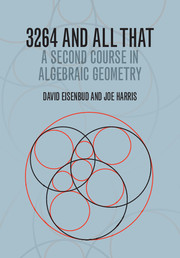Book contents
- Frontmatter
- Contents
- Preface
- Chapter 0 Introduction
- Chapter 1 Introducing the Chow ring
- Chapter 2 First examples
- Chapter 3 Introduction to Grassmannians and lines in ℙ3
- Chapter 4 Grassmannians in general
- Chapter 5 Chern classes
- Chapter 6 Lines on hypersurfaces
- Chapter 7 Singular elements of linear series
- Chapter 8 Compactifying parameter spaces
- Chapter 9 Projective bundles and their Chow rings
- Chapter 10 Segre classes and varieties of linear spaces
- Chapter 11 Contact problems
- Chapter 12 Porteous' formula
- Chapter 13 Excess intersections and the Chow ring of a blow-up
- Chapter 14 The Grothendieck Riemann–Roch theorem
- Appendix A The moving lemma
- Appendix B Direct images, cohomology and base change
- Appendix C Topology of algebraic varieties
- Appendix D Maps from curves to projective space
- References
- Index
Chapter 0 - Introduction
Published online by Cambridge University Press: 05 March 2016
- Frontmatter
- Contents
- Preface
- Chapter 0 Introduction
- Chapter 1 Introducing the Chow ring
- Chapter 2 First examples
- Chapter 3 Introduction to Grassmannians and lines in ℙ3
- Chapter 4 Grassmannians in general
- Chapter 5 Chern classes
- Chapter 6 Lines on hypersurfaces
- Chapter 7 Singular elements of linear series
- Chapter 8 Compactifying parameter spaces
- Chapter 9 Projective bundles and their Chow rings
- Chapter 10 Segre classes and varieties of linear spaces
- Chapter 11 Contact problems
- Chapter 12 Porteous' formula
- Chapter 13 Excess intersections and the Chow ring of a blow-up
- Chapter 14 The Grothendieck Riemann–Roch theorem
- Appendix A The moving lemma
- Appendix B Direct images, cohomology and base change
- Appendix C Topology of algebraic varieties
- Appendix D Maps from curves to projective space
- References
- Index
Summary
Es gibt nach des Verf. Erfarhrung kein besseres Mittel, Geometrie zu lernen, als das Studium des Schubertschen Kalküls der abzählenden Geometrie.
(There is, in the author's experience, no better means of learning geometry than the study of Schubert's Calculus of Enumerative Geometry.)
–B. L. van der Waerden (in a Zentralblatt review of An Introduction to Enumerative Geometry by Hendrik de Vries).
Why you want to read this book
Algebraic geometry is one of the central subjects of mathematics. All but the most analytic of number theorists speak our language, as do mathematical physicists, complex analysts, homotopy theorists, symplectic geometers, representation theorists…. How else could you get between such apparently disparate fields as topology and number theory in one hop, except via algebraic geometry?
And intersection theory is at the heart of algebraic geometry. From the very beginnings of the subject, the fact that the number of solutions to a system of polynomial equations is, in many circumstances, constant as we vary the coefficients of those polynomials has fascinated algebraic geometers. The distant extensions of this idea still drive the field forward.
At the outset of the 19th century, it was to extend this “preservation of number” that algebraic geometers made two important choices: to work over the complex numbers rather than the real numbers, and to work in projective space rather than affine space. (With these choices the two points of intersection of a line and an ellipse have somewhere to go as the ellipse moves away from the real points of the line, and the same for the point of intersection of two lines as the lines become parallel.) Over the course of the century, geometers refined the art of counting solutions to geometric problems—introducing the central notion of a parameter space, proposing the notions of an equivalence relation on cycles and a product on the equivalence classes and using these in many subtle calculations. These constructions were fundamental to the developing study of algebraic curves and surfaces.
In a different field, it was the search for a mathematically precise way of describing intersections that underlay Poincaré's study of what became algebraic topology. We owe Poincaré duality and a great deal more in algebraic topology directly to this search.
- Type
- Chapter
- Information
- 3264 and All ThatA Second Course in Algebraic Geometry, pp. 1 - 12Publisher: Cambridge University PressPrint publication year: 2016

